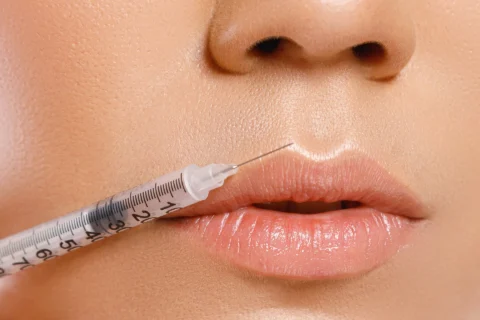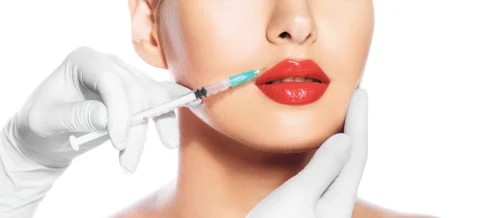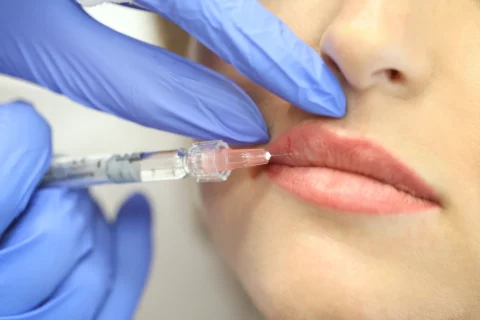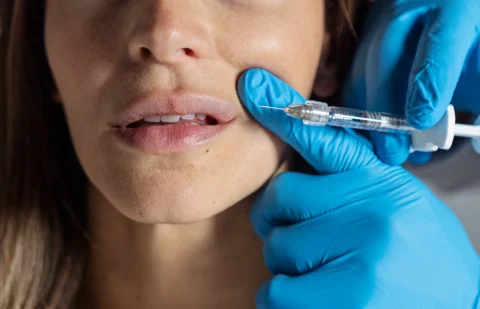Lip injections are one of the hottest trends amongst women both young and old today. Patients as young as 19 are coming in for fillers asking for Kylie lips, and it’s no surprise that one of their major concerns is pain and anesthesia.
So what are the anesthesia options for reducing pain in lip injections? There are quite a few, ranging from topical medication (numbing cream) to vibration anesthesia and dental blocks. The type of anesthesia best for you depends on your comfort, pain levels, and the expertise of your doctor.
Do I Need Anesthesia for Lip Injections?
The primary function of anesthesia is pain control. Many patients who undergo lip injections may not be accustomed to the sharp injections, which can range anywhere from four to twenty pricks for a single session.
As the mouth and lip area is very sensitive, it can be extremely discomforting to opt for a lip filler procedure without the use of some kind of anesthetic. The type of injection method used will help determine your choice for anesthetic. Lip fillers can be injected with the traditional needle or with the blunt tipped cannula.
Needle VS Cannula
The needle penetrates into the lip and is pushed into the injection area for the filler. However, the cannula is blunt tipped instead of sharp, meaning a needle is used to first create an entry point in the skin, which the cannula can exit and enter several times, saving the patient the pain of additional punctures.
Needles can also be more damaging to the lips, with a higher possibility of swelling and bruising (if it passes through a vein). A cannula will instead push the vein aside rather than passing through it, reducing the possibility of swelling and bruising.
Finally, the cannula is generally more flexible and longer than the needle, meaning it can deliver the filler more smoothly. The advantage of the needle is its added precision and control over the cannula. In many cases, the choice of a cannula or a needle for a lip filler depends on the personal preference of the doctor and the patient.
What Does Anesthesia Do?
The body has natural, autonomous ways of reacting when it experiences trauma or pain. Even if you are in the safe hands of a medical professional, the body will still react as if it is in danger. Some of the ways your body reacts to pain includes:
- Shorter breaths
- Swollen tissue
- White blood cells are sent to the injury to begin repairing it
- Increased heart rate
Aside from dulling the pain from an injection or incision, the purpose of an anesthetic is to suppress the body’s natural reactions, as they may interfere with the procedure and recovery.
How Does Anesthesia Work?
While the exact mechanics of anesthesia are not completely understood, the effects of anesthesia are dependent on certain individual factors, including the weight and the body fat of the patient.
When injected into or applied to the body, anesthesia can work in several ways:
- Creating pain relief
- Making a patient unconscious
- Creating memory loss
- Rendering the body immobile
- Eliminating the body’s natural responses to pain
In the case of lip filler injections, anesthesia is used simply as a pain relief mechanism. The type of anesthesia determines the way this pain relief is produced.
Different Types of Lip Injection Anesthesia
| Anesthesia | What is it? | How is it applied? | How does it work? | Other information |
| Topical Medication | Topical medication, also known as numbing cream, is perhaps the most popular form of anesthesia for lip injections. | The cream is applied to the lips prior to the injections. This reduces the pain and reduces the possibility of swelling or bruising. The cream is removed before the lip filler procedure begins, after the lips have become numbed. | Numbing cream products generally contain an active ingredient known as lidocaine, which is a local anesthetic that numbs nerve pain receptors upon application. This works by blocking the pain signal pathways on the nerves by preventing the movement of sodium along the nerve endings, which leads to the pain signals. | The numbing cream can take up to 45 minutes before patients experience the full numbness. |
| Local Injection | A local injection is an injection of local anesthesia directly or around the area, in this case the lips. | The needle is filled with the chosen local anesthesia for the procedure, and it is injected directly into the lips. The injection site for a local injection is usually around the upper part of the lip, as this can block the fibers while doing minimal effect to the anatomy. | The drug given in a local injection will depend on any allergic reactions you may have, other medications that you are currently on, as well as your weight, height, and more (although these factors are less important in simple lip filler procedures). The drugs in the injection influence the pain receptors in the lips. | Local injections can be problematic for lip filler procedures as they can distort the anatomy of the lips, which will make it harder to properly apply the lip fillers in the designated areas. |
| Regional Nerve Block | Regional nerve block (regional anesthesia) is a type of anesthesia that works by blocking sensation in an entire region of the body; in this case, the lips. It offers faster recovery and fewer side effects for patients than other kinds of anesthesia. | Regional nerve block involves an injection, in which the numbing medication for the regional anesthesia is injected into the part of the lips that contains the nerves responsible for pain signals. | The nerves become blocked by the regional anesthesia, stopping the patient from feeling pain during and after the lip filler procedure. | Patients who take regional nerve block for their lip fillers can experience little to no side effects. However, some patients are still reluctant for this type of anesthetic as it involves the use of an injection. |
| Ice and Pressure | An ice pack that is firmly applied during and after the procedure. | After the lips have been injected with the lip filler, the doctor may apply an ice pack firmly against the lips for a few minutes. This helps to reduce swelling and bruising in the area. | Ice packs are well-known to minimize swelling around areas of injury or trauma, such as injection sites. They reduce pain-related swelling and inflammation, and reduce the possibility of bruise development. | Ice packs are also helpful for providing a distraction from the pain after the procedure. |
| Dental Block | A dental block is an injection of an anesthetic (generally lidocaine) to the mental nerve or infraorbital nerve, which is done directly through the mouth. | The injection of lidocaine or another anesthetic agent is done through the mouth, similar to a dentist’s dental block. For lip fillers, both the mental nerve and the infraorbital nerve need to be injected with anesthesia. | The mental nerve and the infraorbital nerve are responsible for providing sensation to the lips and other parts of the face (such as the nose and lower eyelid). By injecting lidocaine (which can work within 5 minutes and lasts up to 2 hours) into these two areas through the mouth, the upper lip can become numbed, although the numbing sensation is not always completely successful. | Many patients who are sensitive to pain opt for a dental block, as it can be one of the most effective ways to completely numb both the lower and upper lip. However, the act of getting the dental block can be painful in itself. |
| Vibration Anesthesia | Vibration anesthesia is comfort created by vibration devices that can reduce the pain of lip filler procedures with vibrations. | Vibration anesthesia can be applied with other types of anesthesia, and works by applying the vibration device to the face while the anesthetic or the lip fillers are injected into the lips. | The vibration device works in accordance to the Gate Control Theory of Pain, which theorizes that when the spinal cord is stimulated by somatic sensation, the pain “gate” can be suppressed, preventing pain signals from reaching the brain. | This method of anesthetic is preferred when there is a risk of dermatitis or allergy in the patient from other types of anesthetic, such as injections and creams. |
| Mucosal Block | The mucosal block is a type of nerve block similar to a dental block that involves blocking the infraorbital nerve by injecting near the oral mucosa, or the mouth’s inside mucous membrane lining. | A topical anesthetic is first applied to the inner linings of the mouth. The anesthetic is the injected at various points in the mouth – along the maxilla, around the mucosa, and then repeated on the opposite side. The final step involves applying topical anesthetic on the oral mucosa. | The mucosal block technique works in a similar way as the dental block technique, in that it involves blocking the infraorbital nerve. It can be more effective in most patients, numbing the lips as quickly as 15 seconds after the injection. | Like the dental block, this technique involves several injections in the mouth, which may be uncomfortable for some patients. |
| Laughing Gas | Laughing gas, or nitrous oxide, is a sedative agent that is made up of oxygen and other gases. It is used to help patients relax and feel more comfortable during certain procedures, such as lip filler procedures. | Laughing gas is given to patients through inhalation. Patients are fitted with a small mask over their nose, and the nitrous oxide is given to the patient through the mask. This sedative agent is completely safe to inhale, and patients will remain conscious but light-headed during the procedure. | Nitrous oxide creates a sense of euphoria in the brain, reducing the sensation of pain and the feelings of anxiety and fear. Nitrous oxide works by preventing the brain and the blood from inhaling its normal level of oxygen. This safe state of oxygen deprivation leads to the lack of anxiety and pain. | Laughing gas is not commonly used for lip filler procedures, however for patients with higher levels of anxiety and fear of the procedure, it can be requested. |
Possible Anesthesia Complications

Patients undergoing lip filler procedures have little to worry about regarding possible anesthesia complications, as most common side effects of anesthesia are related to general anesthesia, not the type of anesthesia used to numb lips for lip filler procedures. Some of these complications may include:
- Intubation injury
- Respiratory arrest
- Bronchospasm
- Laryngospasm
- Aspiration
- Myocardial infarction
- Cardiac arrest
- Myocardial ischemia
- Hypotension
If you have undergone anesthesia with lidocaine in the past, you may want to consult your doctor about the possibility of lidocaine toxicity, in which a patient has been injected with too much lidocaine. However, this should not be an issue with any experienced and trusted doctor.
Ethos Spa, Your Home for Safe Lip Fillers
Safety and pain are major concerns for many people considering lip fillers for the first time, and at Ethos Aesthetics + Wellness, we understand the importance of those concerns. A lip filler procedure should be exciting, and patients shouldn’t worry about the discomfort and pain of the procedure and recovery.
With an experienced and knowledgeable team of trusted doctors by your side, Ethos Spa truly provides an ideal home for lip fillers and more.
To learn more about lip filler anesthetic options and the lip filler procedure itself, contact us at Ethos Spa and schedule your consultation today.







